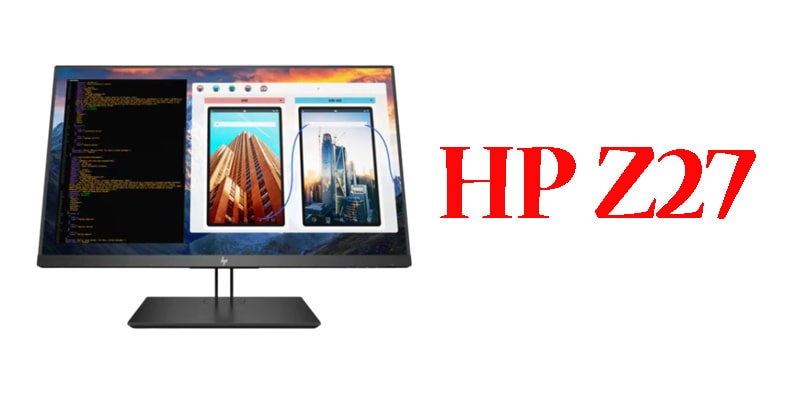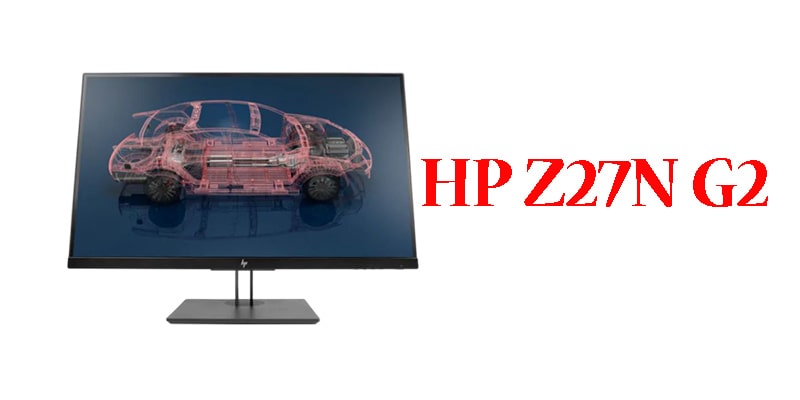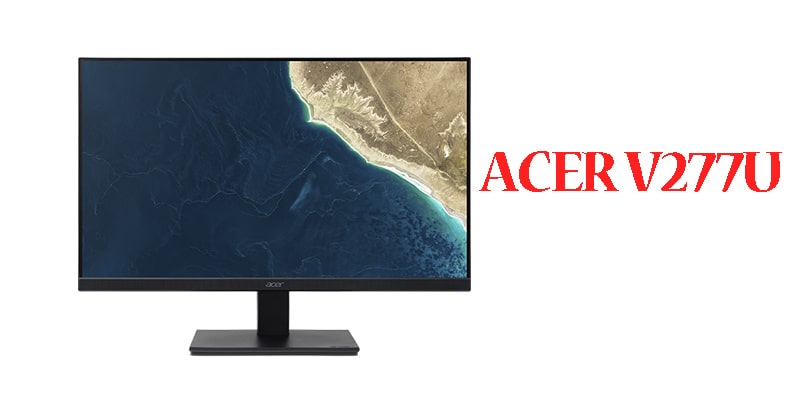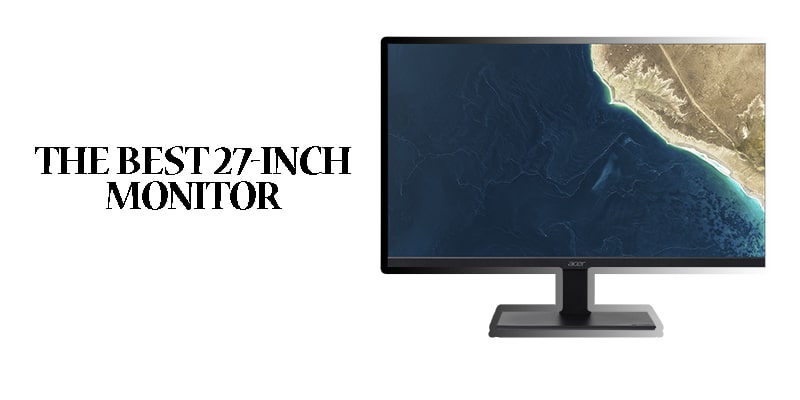Many people purchasing a 27-inch monitor screen ought to get the HP Z27. It’s a shading precise 4K screen with a lot of valuable ports, and it can charge a USB-C PC. In any case, in the event that you have a more seasoned PC that can’t utilize a 4K screen, on the off chance that you have applications that don’t scale well, or in the event that you need to set aside some cash, HP’s Z27n G2 is your best choice.
HERE ARE THE BEST 27 INCH MONITO, THAT YOU SHOULD BUY
1-HP Z27-The best 27-inch screen

27-inch monitor The HP Z27 has an ergonomic stand that you can change for tallness just as tilt, turn, and rotate, and HP’s three-year guarantee and dead-pixel strategy are about on a par with you can get with any screen. It likewise has a USB-C port that can convey the presentation signal, USB information, and up to 65 watts of control over a link, all that anyone could need to charge generally 13-and 15-inch PCs; it’s an incredible choice in case you’re attempting to wipe out link mess.
2-HP Z27n G2-Best Buy

The 2560×1440 (QHD) goals of the HP Z27n G2 isn’t as sharp as a 4K screen, however, this screen is less expensive than our top pick and similarly as shading exact. It additionally accompanies an almost indistinguishable movable stand, three-year guarantee, and dead-pixel strategy, and it will work incredible with applications that can’t scale to 4K or more established PCs purchased before 2015. Its USB-C ports don’t put out enough capacity to charge a PC, and it’s less shading precise than other QHD models we’ve tried, yet its Photo shading preset is more than adequate for a great many people. On the off chance that you need a QHD screen that can charge a PC, we have a few alternatives in the Competition segment; the Lenovo P27h comes the nearest to the HP Z27n G2 in highlights, precision, and cost, yet Lenovo has a more regrettable dead-pixel strategy.
3-Acer V277U bmiipx-A modest yet better than average choice

The V277U 2560×1440 IPS screen is an incredible screen at the cost, yet it’s not particularly exact except if you adjust it yourself. Its stand is awful, as well, and it has neither a USB centre point nor USB-C.
Acer’s V277U bmiipx (truly, this is the complete name) generally costs, in any event, $100 not exactly extraordinary 1440p screens from HP, Lenovo, Dell, and different contenders. What’s more, there are explanations behind that: It’s not particularly precise out of the case (however it’s not shocking), Acer’s dead-pixel strategy on its three-year guarantee isn’t as liberal as HP’s, the screen has neither a USB centre nor USB-C ports, and it wobbles like a bobblehead on its modest stand, which can just tilt the screen all over. However, these are for the most part regular blemishes in spending screens, and the V277U hangs out in different manners: Its differentiation proportion is excellent, and it covers 98 per cent of the DCI-P3 shading array, a component ordinarily saved for considerably more costly screens (different presentations we tried came more like 80 per cent). Without adjustment, it’s an OK, modest screen with a decent guarantee; with alignment (video) and a screening arm, it’s an astounding worth.
Acer’s V277U bmiipx (truly, this is the complete name) ordinarily costs, at any rate, $100 not exactly extraordinary 1440p screens from HP, Lenovo, Dell, and different contenders. What’s more, there are explanations behind that: It’s not particularly exact out of the case (however it’s not repulsive), Acer’s dead-pixel strategy on its three-year guarantee isn’t as liberal as HP’s, the screen has neither a USB centre point nor USB-C ports, and it wobbles like a bobblehead on its modest stand, which can just tilt the screen all over. In any case, these are on the whole regular imperfections in spending screens, and the V277U hangs out in different manners: Its differentiation proportion is excellent, and it covers 98 per cent of the DCI-P3 shading array, a component typically held for significantly more costly screens (different presentations we tried came more like 80 per cent). Without adjustment, it’s a not too bad, modest screen with a decent guarantee; with alignment (video) and a screening arm, it’s an astonishing worth.
How Can You Pick Best Of All
These are the highlights you should search for in a 27-inch monitor screen:
Board type:
- Your screen’s presentation ought to be IPS, not TN (or VA), since IPS boards give much better review points and shading proliferation.
Goals:
- For a 27-inch monitor screen, 1080p is too low a goal. The best screens are 4K; acceptable ones are 2560×1440, otherwise called Quad HD or QHD.
Ports:
- HDMI and DisplayPort associations are the two prerequisites for any great screen. HDMI is one of the most widely recognized ports, in PCs as well as in-game consoles, media spilling gadgets, and different hardware. DisplayPort is a comparable standard that additionally permits you to daisy-chain good screens. Incredible screens ought to likewise incorporate a USB 3.0 centre point so you can associate peripherals to your PC while limiting the number of links racing to a PC sitting under your work area. In our examination, we firmly favour screens with USB-C—which takes into account the transmission of the two information and control over a solitary link, decreasing link mess on and under your work area—however, we don’t make it a prerequisite.
Shading precision:
- Since the vast majority don’t align their screens, out-of-the-crate shading exactness is vital. For the best picture quality, your screen ought to likewise cover however much of the sRGB shading extent as could reasonably be expected; the more array inclusion a screen gives, the more extensive the scope of hues it can precisely speak to. In case you’re accomplishing proficient picture take a shot at the screen, we suggest either adjusting it yourself or recruiting an expert.
Flexibility:
- Many individuals invest hours at an energy before their screens—if a screen doesn’t permit you to appropriately adjust it for right stance, your body can follow through on the cost. Screens with stands that can tilt, turn, and rotate; tallness alterations are incredible, as well. The most ergonomic choice, and a prerequisite for picks, is the capacity to connect to a screen arm by method of a VESA mount. Great screen arms can cost an extra $100 to $200.
Guarantee and client support:
- A decent dead-pixel strategy that shields your buy from splendid and dim pixel surrenders is significant. Three-year guarantees are normal (however not all inclusive) among 27-inch screens. Responsive client assistance is significant as well, in the event that you run into any issues.
On-screen show:
- Your screen’s on-screen show should make it simple to change settings, for example, brilliance, difference, info, and shading preset. The catches—regardless of whether capacitive or physical—ought to likewise be anything but difficult to utilize.
We glanced through the sites of screen producers, for example, Acer, Asus, BenQ, Dell, HP, LG, and ViewSonic, and we found around 32 QHD models to consider (notwithstanding the 4K models we considered for our 4K screens guide and models we’ve just excused for past adaptations of the guide). We wiped out screens that didn’t meet our rules, weren’t promptly accessible through built up retailers, or were fundamentally more costly than different screens we considered.
Our pick: HP Z27 27-inch monitor
The HP Z27, which we prescribe in our manual for the best 27-inch screen, on a work area.
The HP Z27 offers incredible shading precision, an ergonomic stand, an assortment of helpful ports—including a USB-C port with DisplayPort and 65 W power conveyance—and a three-year guarantee.
The 4K HP Z27, our pick for the best 4K screen, is additionally the best 27-inch screen for the vast majority since it offers precise hues in addition to simple ergonomic alterations that permit you to tilt, turn, rotate, and change the tallness of the screen. It additionally has a wide assortment of valuable ports, for example, USB 3.0 and USB-C. The USB-C port lets you transmit information and video and charge a USB-C PC at 65 W, all over a solitary link. Huge numbers of the screens we tried were about as shading exact as the Z27 and had comparative highlights, however the USB-C port gave it the edge over the opposition. It likewise has small bezels around the side and the top, and it accompanies a three-year guarantee and dead-pixel strategy.
The Z27’s picture quality is extraordinary. In our tests, it had DeltaE estimations of 2.97 for grayscales, 2.31 for shading focuses, 2.68 for ColorChecker, and 2.42 for its immersion clear. Those numbers imply that in spite of the fact that the screen isn’t totally exact, you’d have to see it close to a reference photograph or an expertly adjusted screen to differentiate. It additionally has a complexity proportion of 1,002:1—not the most elevated difference proportion of any 4K screen we tried, however close.
The best non-4K screen: HP Z27n G2
The HP Z27n G2 appeared on a work area.
On the off chance that your programming can’t utilize a 4K screen, the Z27n G2 is a 2560×1440 model with great shading precision, a flexible stand, and a port choice that is nearly comparable to on the 4K Z27.
The HP Z27n G2 is neither the most shading precise QHD screen we tried nor the least expensive, yet it’s certainly the best worth you can get for the cash. Its shading exactness is entirely acceptable—the Z27n G2’s Photo preset was commonly the most precise in our testing, however its default Neutral preset wasn’t far-removed. It has a HDMI port, a DisplayPort, a DVI port, three USB 3.0 Type-A ports, and two USB-C ports, one on its side and one on the back. Its stand is similarly as movable as the one on the Z27, our 4K pick, and the Z27n G2 accompanies a similar extraordinary three-year guarantee and dead-pixel strategy as the Z27. Its USB-C ports put out substantially less force—10 W for the side-mounted port and 15 W for the back mounted port—which implies that you can’t utilize them to charge a PC at max throttle. Be that as it may, on the off chance that you can’t or don’t have any desire to purchase a 4K screen, this is the screen to get.
Similarly as with the 4K HP Z27, the Z27n G2’s DeltaE 2000 qualities (for its Photo preset) land in or close to the 2.0 territory—they’re not entirely exact, however they come so close that you’d have to see the Z27n G2 close to an expertly aligned screen to differentiate. We discovered its shading focuses at 1.71, its ColorChecker at 2.06, and its immersion clear at 1.61. On the off chance that you take a gander at the ColorChecker diagram beneath, you’ll see that things generally look superb, except for a bunch of red and orange shades; pictures with those hues in them may not look very as exact as others.
The ColorChecker results for the Z27n G2, indicating less precision in reds and oranges.
The Z27n G2’s ColorChecker results were for the most part incredible, however, a few reds and oranges were somewhat less exact than we’d prefer to see.
A grayscale test for the HP Z27n G2, demonstrating a score of 2.37.
Its grayscale results were far and away superior—dark ought to consistently look dim, not colored with some other shading.
The Z27n G2’s grayscale score was 2.37, far better than that of the 4K Z27 (however it’s hard to differentiate with your unaided eye); subsequently, shades of dark on the Z27n G2 ought to be liberated from some other shading color. Furthermore, its 1,056:1 differentiation proportion is acceptable, however all the QHD screens we tried for this update had different proportions of 1,000:1 or better. Blacks on any of these screens will look pretty dark.
The stand inclines, turns, rotates, and modifies in tallness, so you can make the screen agreeable to take a gander at paying little heed to your work area arrangement; just a screen arm (which the Z27n G2 bolsters) can give you greater adaptability. In our tests, the stand was steady regardless of how we balanced the screen, however, the screen could wobble a piece on the off chance that we knock the work area. (This was valid for each screen we tried, and it’s difficult to maintain a strategic distance from with screens this large.)
The backports of the Z27n G2 screen.
The Z27n G2 has an assortment of ports, however, we wish the USB-C port could yield enough capacity to charge a PC. Photograph: Andrew Cunningham
HP’s standard three-year screen guarantee and dead-pixel strategy together make for probably the best inclusion you can get with any screen; HP will supplant your screen in the event that it has any brilliant subpixels, just as in the event that it has in excess of four dull or dead subpixels. Dell’s dead-pixel strategy covers just splendid pixels, while other screen makers offer short dead-pixel strategies or none by any means.
The Z27n G2’s controls are on the base of the screen on the correct side—not having the option to see the catches in some cases makes it difficult for you to advise which catch relates to which on-screen control, however, the menus let you effectively explore and make changes. In the event that shading exactness is imperative to you, utilize the Photo preset rather than the Neutral preset—in our tests, it was imperceptibly progressively precise, however the Neutral preset wasn’t awful. You additionally need to turn the screen’s Power Saver mode off in the event that you need to utilize the USB-C port for video or on the off chance that you need to utilize the screen’s USB center point by any stretch of the imagination.
Spending pick: Acer V277U bmiipx
The Acer’s V277U bmiipx appeared in a work area.
A modest yet good choice
The V277U 2560×1440 IPS screen is an incredible screen at the cost, yet it’s not particularly exact except if you adjust it yourself. Its stand is terrible, as well, and it has neither a USB center point nor USB-C.
Acer’s V277U bmiipx as a rule costs, in any event, $100 not exactly the HP Z27n G2. What’s more, there are explanations behind that: It’s not precise out of the container (however it’s not horrendous), Acer’s dead-pixel strategy on its three-year guarantee isn’t as liberal as HP’s, the screen has no USB center point or USB-C ports, and you might need to add a screening arm to supplant the shaky stand. Be that as it may, in case you’re not doing proficient photograph altering work and you couldn’t care less about turning or flipping your screen, this is an incredible looking screen at the cost, and because of its noteworthy differentiation proportion and shading array inclusion, it could be sufficient for very good quality photograph work on the off chance that you align it yourself.
The ColorChecker results for the Acer model.
The V277U’s hues aren’t especially exact, and the mistake is spread over the shading range—no shading appears to be significantly more or less precise than some other.
On the off chance that all you intend to do with your screen is take a gander at it with your own eyes, the V277U looks extraordinary; motion pictures and games seem dynamic and bright, and this screen is fine for an easygoing photograph or video altering. In any case, in case you’re altering photographs and recordings expertly for others to take a gander at, the V277U likely wouldn’t be precise enough for you out of the crate, even on its Graphics preset (its most-exact preset). In our tests, its DeltaE 2000 qualities were for the most part somewhere in the range of 3.0 and 4.0; anything above 3.0 starts to glance erroneous in examination with a reference photograph.
The V277U’s shading focuses were at 3.36, its ColorChecker score was 3.86 (however most shades of most hues were similarly tricky), and its immersion clear was at 3.29. The screen’s saving graces are its grayscale estimations—at 2.49, it’s about as precise as our different picks—it’s uncommon 1,142:1 complexity proportion, and the way that it covers the vast majority of the DCI-P3 shading range. A screen that covers DCI-P3 can show a more extensive assortment of red and green shades than average sRGB screens can, and albeit a great many people don’t have to think about that, it very well may be valuable for the top of the line video and photograph altering on the off chance that you’ve appropriately adjusted the V277U.
The grayscale test results for the Acer model, demonstrating a score of 2.49.
The V277U’s grayscale score is around equivalent to the Z27n G2’s—shades of dim should look for the most part dim with no shading color.
Be that as it may, in most different ways, the V277U feels precisely like a modest PC screen. The entire thing feels plasticky and light, and the average, shaky stand offers neither tallness changes nor turning or rotating. Since it’s VESA-good, you can generally change the screen’s stand apart for a screening arm, however, our different picks have significantly more adaptable default stands.
The ports on the base edge of the Acer screen.
The V277U has two HDMI ports and one DisplayPort, which is a satisfactory least, yet in the event that you need a USB center point or a USB-C port, you have to look somewhere else. Photograph: Andrew Cunningham
The rear of the Acer model.
The V277U is less expensive-looking, shabbier inclination, and more plasticky than our different picks, and its modest stand lets you just tilt the screen all over. Photograph: Andrew Cunningham
The ports on the base edge of the Acer screen.
The V277U has two HDMI ports and one DisplayPort, which is an adequate least, however, in the event that you need a USB center point or a USB-C port, you have to look somewhere else. Photograph: Andrew Cunningham
Acer’s three-year guarantee covers its screen for a similar measure of time as HP’s guarantee accomplishes for its models, yet the organization’s dead-pixel strategy isn’t as acceptable. HP will supplant your screen on the off chance that it has any splendid subpixels whatsoever, or on the off chance that it has at least four dim or dead subpixels. Acer’s, conversely, requires, in any event, two brilliant subpixels, five dull or dead subpixels, or an aggregate of five inadequate subpixels of either type. Any dead-pixel strategy whatsoever is superior to none, however, on the off chance that your screen builds up a solitary difficult brilliant subpixel, Acer can’t get you out.
The V277U’s controls are situated on the rear of the screen, constraining you to grab indiscriminately for the catches, and you need to explore with an odd, joystick-esque handle. I inadvertently killed the screen when I was attempting to alter it, however, once you get it the manner in which you like it, you shouldn’t need to meddle with the controls regularly.
FAQS
1-How big is a 27 inch monitor?
This thing Dell P2714H IPS 27-Inch Screen LED-Lit Monitor
Dell Professional P2717H 27″ Screen LED-Lit Monitor,Black
Show Resolution Maximum 1920 x 1080 1920X1080 pixels
Screen Size 27 inches 27 inches
Show Type LED LED
Thing Dimensions 21.22 x 25.25 x 8.03 inches 24.45 x 14.41 x 1.98 inch
2-How far away should you sit from a 27-inch monitor?
The 27-inch monitor on the off chance that you are utilizing a hello there goals screen (for example 2560×1440), at that point about a manageable distance is about ideal for the vast majority. Be that as it may, on the off chance that you are simply discussing a 1920×1080 (1080p), at that point you should sit somewhat further back, except if you wouldn’t fret see the space between pixels or you have a touch screen.
3-Is 27-inche monitor too big for a monitor?
27-inch monitor truly merits 1440p. I’m excessively coddled by it at home, however, I wish I that at work. So to ensure you have the ideal experience you need to factor in the survey separation and goals of the screen/TV. Fundamentally the recipe is 1.5-2.5 occasions the slanting for 1080P and 1-1.5 occasions the askew for 4K

